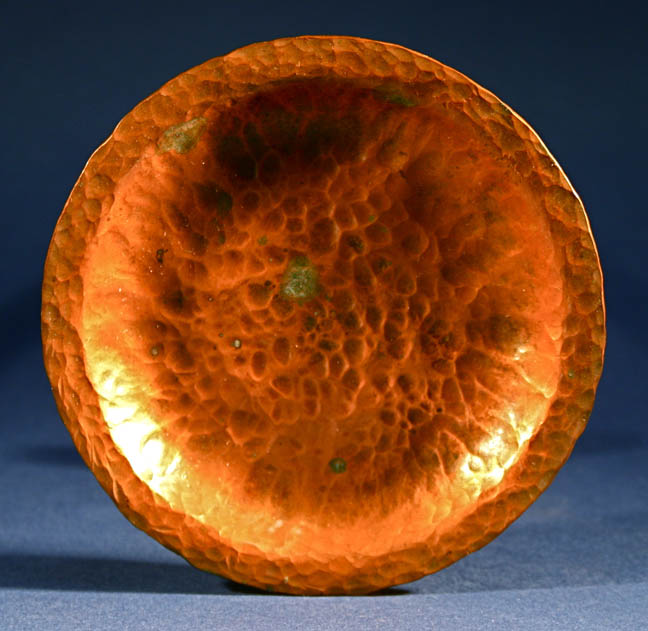

Title: Antique Hand Hammered Arts & Craft Copper Dishes By Dirk Van Erp
Shipping: $29.00
Artist: N/A
Period: 19th Century
History: N/A
Origin: North America > United States
Condition: Museum Quality
Item Date: 1860 - 1933
Item ID: 4484
These hammered copper little nine plates look like they were made by famous San Francisco Bay Area metalsmith, Dirk van Erp. This classic "Hammered" design was created in the early 20th century. The undulating hand hammered work is a very difficult motif to execute in metal. The elegant hammered detail is so beautifully crafted it almost looks like "tooled leather". The inspiration for these hand hammered copper plates were from, Dirk van Erp, the famous metalsmith who was active in the San Francisco Bay Area in the early 20th century. Click on additional images for a closeup of this detail.
Link: http://en.wikipedia.org/wiki/Dirk_van_Erp
Dirk Koperlager van Erp (1860 - 1933) was an Dutch American artisan, coppersmith and metalsmith, best known for lamps made of copper with mica shades, and also for copper vases, bowls and candlesticks. He was a prominent participant in the Arts and Crafts Movement, and was active in Oakland and San Francisco, California.
Dirk van Erp was born January 1, 1860, in Leeuwarden, the Netherlands. His father and other family members were coppersmiths. He immigrated to the United States in 1886, and came to San Francisco in 1890, where he went to work for Union Iron Works. In 1892, he married Mary Richardson Marino and their first child, a daughter named Agatha, was born in 1894. In 1898, he traveled to the Yukon during the Klondike Gold Rush, but failed to find his fortune. He returned to work at the Union Iron Works later that same year.
In 1900, he moved to Vallejo, California, and got a job as a coppersmith at the Mare Island Naval Shipyard. He began making lamps from brass shell casings as gifts to friends. He began consigning metal art works to local shops. His son, William Henry van Erp, was born in April 1901.
In 1908, he opened the Art Copper Shop in Oakland, and began exhibiting his work at local Arts and Crafts exhibitions. In 1909, he exhibited more than two dozen pieces at the Alaska-Yukon-Pacific Exposition, a World's Fair held in Seattle, Washington. His shop won a gold medal.
In 1910, he moved his shop to San Francisco, and entered into a partnership with Elizabeth Eleanor D'Arcy Gaw, (1860 - 1933) who had attended the Art Institute of Chicago. She had also studied English Arts and Crafts in London at the Guild and School of Handicraft, founded by Charles Robert Ashbee. Although their partnership lasted less than a year, she exerted a strong and lasting influence on van Erp's design sensibility. In 1915, van Erp exhibited at the Panama-Pacific International Exposition, a World's Fair held in San Francisco. During World War I, van Erp significantly reduced his artisan production, and returned to employment at Union Iron Works to contribute to the war effort. He resumed his prolific artisan production after the war ended in 1918.
His career continued until his retirement in 1929. He died in Fairfax, California, on July 18, 1933. His wife, Mary van Erp, died four hours later. His son, William van Erp, continued to operate the shop until 1977, when he died.
Kenneth Trapp, curator for decorative arts at the Oakland Museum of California summarized van Erp's legacy as follows: "Although most famous for his lamps, many of which are commanding in size and stunning in design, van Erp produced other pieces of such exceptional beauty and strength as to stand unrivaled in American metalwork." Trapp concluded, "Dirk van Erp is widely considered the most important metalsmith of the Arts and Crafts movement"
A copper and mica lamp ca. 1912 - 1915, designed by D'Arcy Gaw and Dirk van Erp, is in the collection of the Metropolitan Museum of Art in New York City. It was donated in 1989 by Charles and Jane Kaufman.
In June, 2002, a copper and mica lamp designed by D'Arcy Gaw and made by Dirk van Erp was sold for US$180,000 at an auction conducted by The Craftsman and David Rago in Lambertville, New Jersey. A van Erp copper vase sold for US$36,000 at the same auction.
On July 28, 2007, appraiser David Rago discussed a Dirk van Erp lamp on a segment of the Public Broadcasting Service series Antiques Roadshow (American version) filmed that day in Louisville, Kentucky. The value of the copper and mica lamp made around 1912 was estimated at US$40,000 to $50,000.
Mass-produced copies of van Erp's designs are widely reproduced today, but tend to be of lower quality. Modern artisans continue to produce higher quality copper works inspired by van Erp and other classical Arts and Crafts coppermiths. Among them are the artisans of Michoacán, Mexico, whose works are sold under the Cobre brand name.